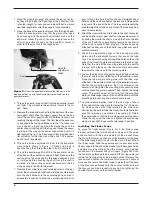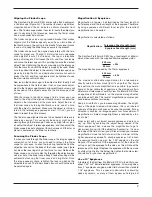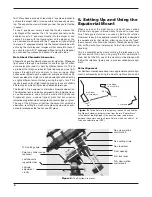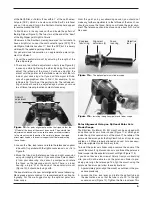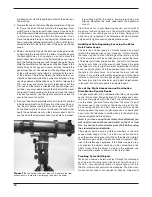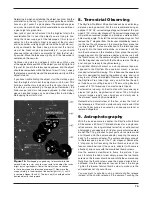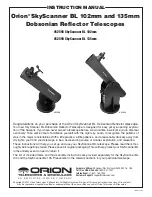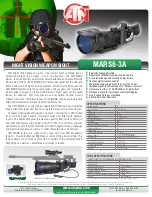
7
aligning the Finder scope
The SkyView Pro 80mm ED EQ comes with a 8x40 achromat-
ic finder scope (Figure 3a). The number 8 means eight-times
magnification and the 40 indicates a 40mm diameter front
lens. The finder scope makes it easier to locate the object you
want to observe in the telescope, because the finder scope
has a much wider field-of-view.
The finder scope uses a spring-loaded bracket that makes
alignment of the finderscope very easy. As you turn either of
the thumb screws, the spring in the bracket’s tensioner moves
in and out to keep the finder scope secure in the bracket.
The finder scope must be aligned accurately with the tele-
scope for proper use. To align it, first aim the main telescope
at an object at least a 1/4 mile away - the top of a telephone
pole, a chimney, etc. First loosen the R.A. and Dec. lock levers
and move the telescope until it is pointing towards the desired
object. Then sight along the tube to precisely aim the telescope.
Turn the focus knob until the object is properly focused. Make
sure to position the object in the center of the telescope’s eye-
piece by turning the R.A. and declination slow-motion control
knobs (the R.A. and Dec. lock levers must be tightened to use
the slow-motion control knobs).
Now look in the finder scope. Is the object visible? Ideally it will
be somewhere in the field of view. If not, some coarse adjust-
ment to the finder scope bracket’s alignment thumb screws will
be needed until the object comes into the finder scope’s field
of view.
With the image in the finder scope’s field of view, you now
need to fine-adjust the alignment thumb screws to center the
object on the intersection of the crosshairs. Adjust the aim of
the finder scope by turning the thumb screws, one at a time,
until the object is centered. Make sure the object is still cen-
tered in the telescope’s eyepiece as well. If it isn’t, you will
need to repeat the entire process.
The finder scope alignment needs to be checked before every
observing session. This can easily be done at night, before
viewing through the telescope. Choose any bright star or plan-
et, center the object in telescope eyepiece, and then adjust the
finder scope bracket’s alignment thumb screws until the star or
planet is centered on the finder’s crosshairs.
Focusing the Finder scope
If, when you look through the finder scope, the images appear
somewhat out of focus, you will need to refocus the finder
scope for your eyes. Loosen the lock ring located behind the
objective lens cell on the body of the finder scope (see Figure
3a). Back the lock ring off by a few turns, for now. Refocus the
finder scope on a distant object by threading the objective lens
cell in or out of the finder scope body. Precise focusing will be
achieved by focusing the finder scope on a bright star. Once
the image appears sharp, retighten the lock ring behind the
objective lens cell. The finder scope’s focus should not need to
be adjusted again.
Magnification & Eyepieces
Magnification, or power, is determined by the focal length of
the telescope and the focal length of the eyepiece. Therefore,
by using eyepieces of different focal lengths, the resultant
magnification can be varied.
Magnification is calculated as follows:
Telescope Focal Length (mm)
Magnification=
Eyepiece Focal Length (mm)
The SkyView Pro 80mm ED EQ has a focal length of 600mm,
which when used with the supplied 25mm eyepiece yields:
600 mm
= 24x
25 mm
The magnification provided by the 10mm eyepiece is:
600 mm
= 60x
10 mm
The maximum attainable magnification for a telescope is
directly related to how much light it can gather. The larger
the aperture, the more magnification is possible. In general a
figure of 2x per millimeter of aperture is the maximum attain-
able for most telescopes. Your SkyView Pro 80mm ED EQ has
an aperture of 80 millimeters, so the maximum magnification
would be about 160x. This level of magnification assumes you
have ideal conditions for viewing.
Keep in mind that as you increase magnification, the bright-
ness of the object viewed will decrease; this is an inherent
principle of the laws of physics and cannot be avoided. If mag-
nification is doubled, an image appears four times dimmer. If
magnification is tripled, image brightness is reduced by a fac-
tor of nine!
Always start with your lowest power eyepiece and work your
way up. Start by centering the object being viewed in the
25mm eyepiece. Then increase the magnification to get a
closer view, if you wish. If the object is off-center (i.e., it is near
the edge of the field of view) you will lose it when you increase
magnification, since the field of view will be narrower with the
higher-powered eyepiece. To change eyepieces, first loosen
the securing thumb screw on the 1.25" adapter on the star
diagonal. Then carefully lift the eyepiece out of the holder. Do
not tug or pull the eyepiece to the sides, as this will knock the
telescope off its target. Replace the eyepiece with the new one
by sliding it gently into the holder. Re-tighten the thumb screw,
and refocus for your new magnification.
use of 2" Eyepieces
A feature of the SkyView Pro 80mm ED EQ is its ability to use
either 1.25" or 2" barrel-diameter eyepieces. At low magnifica-
tions, 2" eyepieces can give a wider field of view than standard
1.25" eyepieces. This is especially desirable for observing
deep-sky objects, as many of them appear quite large, but




